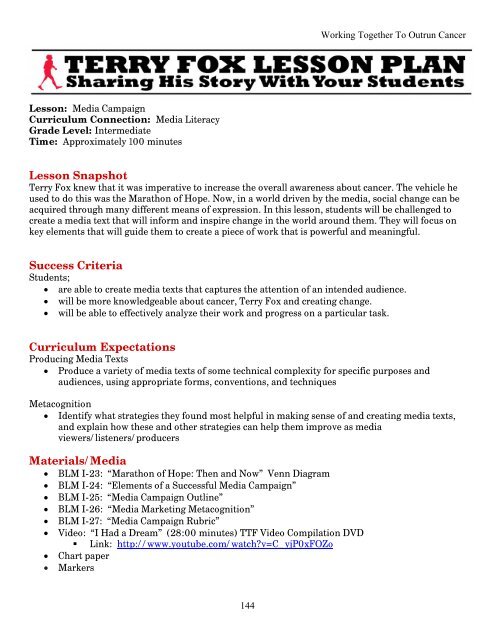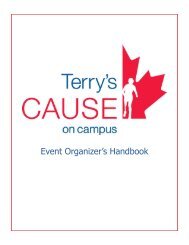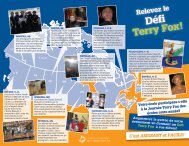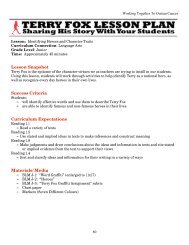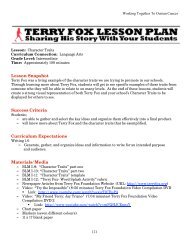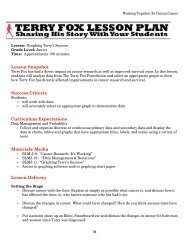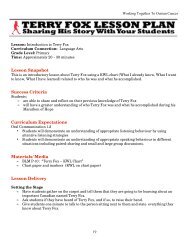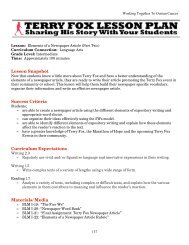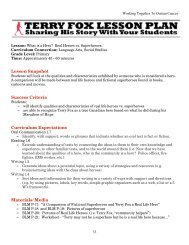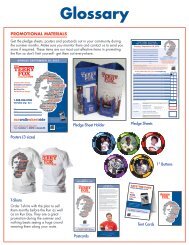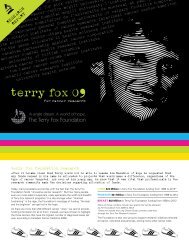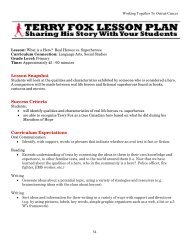Media Campaign - Terry Fox Foundation
Media Campaign - Terry Fox Foundation
Media Campaign - Terry Fox Foundation
Create successful ePaper yourself
Turn your PDF publications into a flip-book with our unique Google optimized e-Paper software.
Working Together To Outrun Cancer<br />
Lesson: <strong>Media</strong> <strong>Campaign</strong><br />
Curriculum Connection: <strong>Media</strong> Literacy<br />
Grade Level: Intermediate<br />
Time: Approximately 100 minutes<br />
Lesson Snapshot<br />
<strong>Terry</strong> <strong>Fox</strong> knew that it was imperative to increase the overall awareness about cancer. The vehicle he<br />
used to do this was the Marathon of Hope. Now, in a world driven by the media, social change can be<br />
acquired through many different means of expression. In this lesson, students will be challenged to<br />
create a media text that will inform and inspire change in the world around them. They will focus on<br />
key elements that will guide them to create a piece of work that is powerful and meaningful.<br />
Success Criteria<br />
Students;<br />
are able to create media texts that captures the attention of an intended audience.<br />
will be more knowledgeable about cancer, <strong>Terry</strong> <strong>Fox</strong> and creating change.<br />
will be able to effectively analyze their work and progress on a particular task.<br />
Curriculum Expectations<br />
Producing <strong>Media</strong> Texts<br />
Produce a variety of media texts of some technical complexity for specific purposes and<br />
audiences, using appropriate forms, conventions, and techniques<br />
Metacognition<br />
Identify what strategies they found most helpful in making sense of and creating media texts,<br />
and explain how these and other strategies can help them improve as media<br />
viewers/listeners/producers<br />
Materials/<strong>Media</strong><br />
BLM I-23: “Marathon of Hope: Then and Now” Venn Diagram<br />
BLM I-24: “Elements of a Successful <strong>Media</strong> <strong>Campaign</strong>”<br />
BLM I-25: “<strong>Media</strong> <strong>Campaign</strong> Outline”<br />
BLM I-26: “<strong>Media</strong> Marketing Metacognition”<br />
BLM I-27: “<strong>Media</strong> <strong>Campaign</strong> Rubric”<br />
Video: “I Had a Dream” (28:00 minutes) TTF Video Compilation DVD<br />
• Link: http://www.youtube.com/watch?v=C_yjP0xFOZo<br />
Chart paper<br />
Markers<br />
144
Working Together To Outrun Cancer<br />
Lesson Delivery<br />
Setting the Stage:<br />
Show “I Had a Dream Video”.<br />
During the video, have students jot down how things have changed since 1980 (ie. cars, TVs,<br />
radio, clothes, etc) and what has stayed somewhat the same using the Venn Diagram provided<br />
(BLM I-23).<br />
After the video, discuss the changes they recorded on their sheet.<br />
Ask students, “How would raising money during the Marathon of Hope be easier<br />
now, than it was back then?”<br />
Lead students into a discussion about how media has evolved due to the Internet and other<br />
improvements in technology.<br />
Core Learning Activity<br />
As a class, brainstorm on an anchor chart the ways in which we would promote the run now.<br />
For instance; TV, Radio, internet, podcasts, social media, blogs, posters, magazines,<br />
newspaper, email, texting, apps, Skype, public service announcements (PSA), commercials,<br />
YouTube videos, etc.<br />
Ask them, “What career is usually responsible for promoting events, products,<br />
etc?”<br />
Discuss how advertising and marketing play a major role in what we choose to buy, like,<br />
support, endorse, etc.<br />
Discuss with students different elements that are important to consider when creating an<br />
advertisement campaign. Lead students to the following ideas: Target audience, Unique<br />
Concept, Strong Content, Creative Design, Appropriate Voice.<br />
Break students into smaller groups and give each group one of these elements. Have them<br />
discuss why these elements are important and give examples from current media campaigns<br />
that support their answers.<br />
Have each group present their ideas and discuss their findings.<br />
As a class, record their ideas under each element on the ‘Elements of a Successful <strong>Media</strong><br />
<strong>Campaign</strong>’ sheet (BLM I-24). Use these ideas as your expectations for their final assignment.<br />
Application of Information<br />
Hand out the ‘<strong>Media</strong> <strong>Campaign</strong> Outline’ sheet (BLM I-25) and discuss expectation for this<br />
assignment using the ‘<strong>Media</strong> <strong>Campaign</strong> Rubric’ (BLM I-27).<br />
Students are to create an advertising campaign for The <strong>Terry</strong> <strong>Fox</strong> <strong>Foundation</strong> that either<br />
promotes their community/school event, <strong>Terry</strong>’s story or increases peoples’ awareness about<br />
cancer.<br />
They may select one or several of the types of advertising discussed earlier in class. A list of<br />
some of the types of advertising are on the ‘<strong>Media</strong> <strong>Campaign</strong> Outline’ (BLM I-25).<br />
Have students work independently, in pairs or small groups depending on your class.<br />
Students must hand in ‘<strong>Media</strong> <strong>Campaign</strong> Outline’ sheet (BLM I-25) with the final copy of their<br />
assignment. This will be used as part of the assessment.<br />
As well, students must complete the ‘<strong>Media</strong> Marketing Metacognition’ sheet (BLM I-26) for<br />
assessment.<br />
145
Working Together To Outrun Cancer<br />
Assessment<br />
Students will be assessed on their final products and the ability to reflect on the assignment using the<br />
rubric provided (BLM I-27). Remember to collect the BLM I-25 and BLM I-26 along with their final<br />
product for assessment.<br />
Extension Activity<br />
Have students look at other marketing campaigns with a direct focus on the five elements discussed in<br />
this lesson. Students could assess these campaigns and present why they are successful or how they<br />
could be improved to be more successful.<br />
146
Working Together To Outrun Cancer<br />
147<br />
BLM I-23
Working Together To Outrun Cancer<br />
148 BLM I-24
Working Together To Outrun Cancer<br />
BLM-24<br />
149<br />
BLM I-25
Working Together To Outrun Cancer<br />
150 BLM I-26
Working Together To Outrun Cancer<br />
151 BLM I-27


